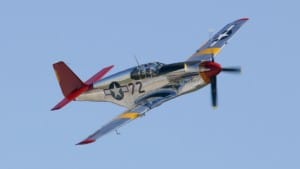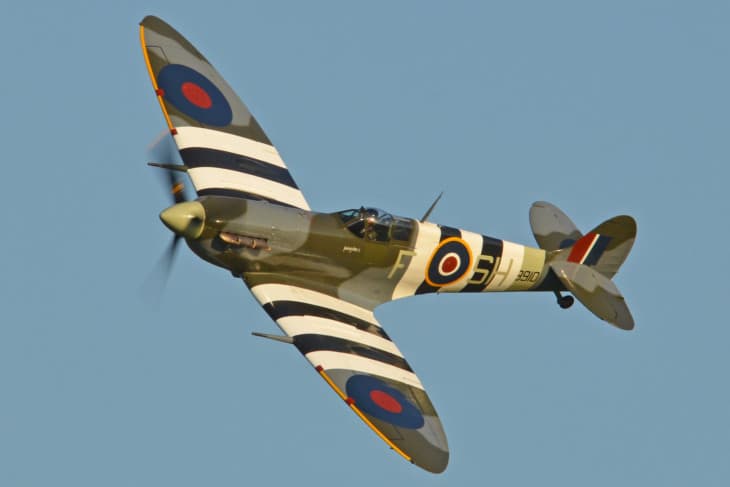You know the saying, “You can’t judge a book by its cover?” Well, that goes for airplanes too. Just because one plane looks made out of metal and wires doesn’t mean it can fly. And just because another plane is sleek and shiny doesn’t mean it’s fast.
What are the implications of this? We have two different planes that look both outstanding in their ways. The first is the P-51 Mustang. The second is the Supermarine Spitfire. These great planes are similar in many ways, but they also differ. Please keep reading and let me explain.
| Aircraft: | North American P-51 Mustang | Supermarine Spitfire |
|---|---|---|
| Photo: |
 |
 |
| Country: | United States | United Kingdom |
| Manufactured: | from: 1940 to: 1945 | from: 1938 to: 1948 |
| ICAO: | P51 | - |
| Price: | $0.59 million | $0.016 million |
| Avionics: | - | - |
| Engine: | 1x Packard (Rolls Royce) V-1650-7 Merlin | 1x Rolls-Royce Merlin 45 V-12 |
| Engine Type: | Piston | Piston |
| Power: | 1,720 horsepower | 1,470 horsepower |
| Max Cruise Speed: |
383 knots 709 Km/h |
320 knots 593 Km/h |
| Approach Speed (Vref): | 87 knots | 68 knots |
| Travel Range: |
1,434 Nautical Miles
2,656 Kilometers |
960 Nautical Miles
1,778 Kilometers |
| Fuel Economy: | - | - |
| Service Ceiling: | 41,900 feet | 37,000 feet |
| Rate of Climb: |
3200 feet / minute 16.26metre / second |
2600 feet / minute 13.21metre / second |
| Take Off Distance: |
366 metre 1,200.77 feet |
306 metre 1,003.92 feet |
| Landing Distance: |
457 metre 1,499.33 feet |
242 metre 793.95 feet |
| Max Take Off Weight: |
5,490 Kg 12,103 lbs |
3,039 Kg 6,700 lbs |
| Max Landing Weight: |
5,490 Kg 12,103 lbs |
3,000 Kg 6,614 lbs |
| Max Payload: |
910 Kg 2,006 lbs |
500 Kg 1,102 lbs |
| Fuel Tank Capacity: |
269 gallon 1,018 litre |
102 gallon 386 litre |
| Baggage Volume: | - | - |
| Seats - Economy: | 1 seats | 1 seats |
| Seats - Business Class: | - | - |
| Seats - First Class: | - | - |
| Cabin Height: | - | - |
| Cabin Width: | - | - |
| Cabin Length: | - | - |
| Exterior Length: |
9.8 metre 32.15 feet |
9.12 metre 29.92 feet |
| Tail Height: | 4.08 metre - 13.39 feet | 3.48 metre - 11.42 feet |
| Fuselage Diameter: |
0.9 metre 2.95 feet |
0.9 metre 2.95 feet |
| Wing Span / Rotor Diameter: |
11.28 metre 37.01 feet |
11.23 metre 36.84 feet |
| Wing Tips: | No Winglets | No Winglets |
| More Info: | North American P-51 Mustang | Supermarine Spitfire |
|
Data presented is for entertainment purposes and should not be used operationally.
|
Other North American P-51 Mustang comparisons:
- Nakajima Ki-84 vs P-51 Mustang
- P-51 vs Me 262
- P-38 Lightning vs P-51 Mustang
- P-51 Mustang vs F4U Corsair
- P-51 Mustang vs P-47 Thunderbolt
- P-51 Mustang vs MiG 15
- P-40 Warhawk vs P-51 Mustang
- F6F Hellcat vs P-51 Mustang
- P-51 Mustang vs Bf-109
- P-51 Mustang vs A6M Zero
Other Supermarine Spitfire comparisons:
About the P-51 Mustang

The P-51 Mustang, affectionately known as the “Cadillac of the Skies,” was a crucial part of the Allied forces during World War II. Its sleek design and superior speed allowed it to escort bomber missions deep into enemy territory, providing protection and support for vulnerable bombers.
The P-51 also proved its mettle as a formidable fighter, shooting down enemy planes with deadly accuracy.
Despite facing initial production delays and skepticism from military officials, the P-51 ultimately proved to be one of the most successful and versatile aircraft in history.
Today, it remains a popular choice for air shows and vintage flight exhibitions, reminding us of its role in shaping modern history. The P-51 may be old-fashioned, but it knows how to put on a show.
Also Read: The Best American Fighter Planes of WWII
Why was the P-51 developed and built?
P-51 is more than just a cool airplane – it symbolizes American innovation and ingenuity. Designed for World War II combat, the P-51 quickly proved a fierce adversary in the skies.
But its prowess didn’t end there – with modifications; it could fly higher and faster than any other aircraft at the time. The P-51 also played a significant role in breaking the sound barrier, allowing for advancements in supersonic flight.
And its iconic design has made it a favorite among aviation enthusiasts, often chosen to lead formation flying demonstrations at airshows. So next time you see a P-51 flying overhead, remember that you’re witnessing incredible aerobatics and watching history in action.
What purpose did the P-51 serve?
P-51 serves and serves many purposes. It is, first and foremost, an American fighter aircraft that saw extensive service during World War II.
Additionally:
- It served as an escort for bombers and protected them from enemy fighters.
- It acted as a ground attack aircraft, targeting tanks, trains, and other ground targets.
- It could also serve as a reconnaissance plane, collecting intelligence on enemy movements.
- And finally, with modifications to its design and engine placement, the P-51 became a successful racing aircraft in post-war competitions.
Though it has been retired from military use for decades now, the P-51 remains an iconic symbol of American aviation prowess, making appearances at air shows and historical events around the world.
Its versatility and success in battle cemented its place in history as one of the most significant fighter planes ever produced.
About the Supermarine Spitfire

As a symbol of the Allies’ victory during World War II, the Spitfire remains one of the most famous fighter planes in history.
Its sleek design and impressive speed made it a formidable opponent in battle, while its agility allowed it to outmaneuver enemy planes. Despite its smaller size compared to other fighter planes, the Spitfire was often able to hold its own against multiple adversaries at once.
Its maneuverability also meant it could fly at low altitudes, making it well-suited for reconnaissance missions and ground attack operations.
New materials such as aluminum alloy improved aerodynamics and allowed more powerful engines. Many pilots have described flying the Spitfire as an exhilarating experience –not an easy feat amid wartime combat.
Today, the legacy of the Spitfire lives on through numerous restored versions that can still be seen performing at air shows or even taking joy rides for lucky aviation enthusiasts.
Also Read: Supermarine Spitfire
Why was the Spitfire developed and built?
The British Royal Air Force had long been searching for a new fighter plane to counter the threat posed by German aircraft. The need for such a plane became even more urgent in 1936 when Germany unveiled their new Messerschmitt Bf-109. As a result, the specification for a new fighter plane, F37/34, was released in 1934.
While several designs were submitted, it was the Supermarine Spitfire that ultimately caught the attention of officials and went into production. With its sleek design and powerful Rolls-Royce Merlin engine, the Spitfire could outperform any enemy aircraft it faced during World War II and quickly became an iconic symbol of British strength and fortitude.
Its success in combat proved the genius behind its design and cemented its place in history as one of the most significant fighter planes ever built.
What purpose did the Spitfire serve?
The following are the different purposes that the Spitfire served:
- First and foremost, it was a successful aerial combatant. Its maneuverability allowed it to engage with enemy aircraft and defend Allied bombers.
- It played a crucial role in the Battle of Britain as part of the Royal Air Force’s defense against German bombing raids.
- In addition to its combat abilities, the Spitfire also symbolized national unity and pride for the British people during the war.
- Finally, it has continued to function as an essential piece of military history, with numerous preserved examples in museums worldwide.
How are the P-51 and Spitfire different?
The P-51 and Spitfire are legendary fighters from World War II, but they were designed for entirely different purposes. Firstly, the P-51 was built as a long-range escort fighter, able to accompany bombers on missions deep into enemy territory.
The Spitfire, on the other hand, was designed for short-range combat and defense of British airspace. Secondly, the P-51 is powered by a massive V12 engine, while the Spitfire’s small form factor allowed it to be powered by a more compact inline engine.
Lastly, while both planes were initially constructed with metal frames, the P-51 eventually incorporated advanced plastic composites in its design – something the Spitfire lacked. In short, though they may look similar at first glance, these two iconic machines served markedly different roles in wartime strategy.
How are the P-51 and Spitfire similar?
Both the P-51 and Spitfire were prominent fighters in World War II, but they also have a lot in common, aside from their wartime roles.
First, both planes were manufactured by countries that were heavily involved in the war: the P-51 was made by the United States, and the Spitfire by Great Britain. Second, both aircraft had impressive speed and maneuverability, making them highly effective in combat.
Third, perhaps most notably, both planes became symbols of their respective countries’ national pride during the war. The P-51’s nickname “Mustang” even became synonymous with American strength and determination on the battlefield. While they may have gone head to head in real life, the P-51 and Spitfire share many similarities as iconic fighters of World War II.
What’s better about the P-51?
There are several things better in this excellent fighter. These include:
Design:
The design of P-51 is better. The plane has a teardrop-shaped fuselage which gives it a sleek look. It is also smaller and more compact than the Spitfire, making it more agile in the air.
Performance:
The P51 outperforms the Spitfire in several key areas. It has a higher top speed and faster acceleration and can fly at higher altitudes. In addition, the P51 is equipped with a superior weapons system, including six .50 caliber machine guns.
Range:
One of the most critical aspects of the P-51 is its long range. With a range of over 1,500 miles, it can escort bombers on missions deep into enemy territory. The Spitfire, on the other hand, has a much shorter span of only around 350 miles.
What’s better about the Spitfire?
Spitfire, on the other hand, has the following advantages:
Maneuverability:
The Spitfire is more maneuverable than the P-51, thanks to its lighter weight and smaller size. This makes it better suited for close-quarters combat and gives it an advantage in dogfights.
Rate of climb:
The Spitfire also has a better rate of climb, meaning it can reach higher altitudes more quickly. This gives it an advantage when engaging enemy aircraft at high altitudes.
Avionics:
While the P-51 is equipped with superior weapons, the Spitfire has better avionics. This includes a more sophisticated radar system and a head-up display for the pilot.
Cost:
Finally, the Spitfire is cheaper to produce than the P51. This is due to its more straightforward design and less expensive materials.
Conclusion
In conclusion, the P-51 and Spitfire are both iconic fighters of World War II. They share many similarities, but each has its unique strengths and weaknesses. Depending on each individual’s needs, either plane could be the better choice. Whichever one you choose, you’re sure to have a powerful and effective war machine at your disposal.


